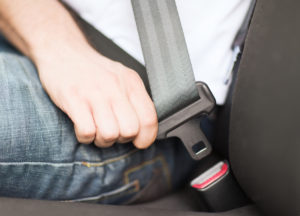
Beautiful spring weather has finally arrived in Connecticut! With the temperatures beginning to climb, more and more people are hitting the not-so-open road. Although it is always the right time to practice road safety, with the increased number of motorists on roadways, it is even more important to be careful and vigilant. One of the easiest and most important ways you can stay safe on the road is by following Connecticut seat belt laws. For those who are unclear as to the laws in place within the state, we’d like to provide a thorough reminder.
Front Seat Use:
Anyone driving a car in Connecticut MUST wear a seat belt by law. Similarly, anyone who is a front seat passenger must also be secured in the car with a seat belt. This law must be followed by anyone who is in the front seat of a car, regardless of age or level of driving experience.
Teenage Drivers:
Drivers between the ages of 16-17 must always wear a seatbelt. Every passenger in their car must also wear a seatbelt when the teen is driving. Any driver or passenger found guilty of not following this law is subject to a fine of $75.
Two-Part Systems:
If your car has a two-part seat belt system, both the shoulder strap and lap belt must be engaged when you are operating the car. If the shoulder strap fastens automatically, you need to still be sure to manually fasten the lap belt. Wearing just one part of the seat belt is unsafe and therefore prohibited by Connecticut law.
Airbags:
Air bags are a safety feature that have become standard equipment in most new cars. However, if your car is equipped with an air bag, it does not make you exempt from wearing a seat belt. Seat belts and airbags work in tandem to keep drivers and passengers safe in the event of an accident. Although airbags will protect you from injury if you hit the steering wheel, seat belts are designed to protect you during side impacts or if the car rolls over.
Connecticut Seat Belt Laws For Children:
Children under the age of 16 need to abide by the following restraint and safety system guidelines.
 Misconceptions Regarding Seat Belts:
Misconceptions Regarding Seat Belts:
Seat belts have been around for a long time, but there are still many misconceptions that perpetuate regarding them, often fueled by those opposed to them. Your best ammunition against this misinformation is to have the facts. Here are some common seat belt misconceptions along with rationale to disprove them.
1. Misconception: I can get trapped inside a car if I’m wearing a seat belt
Fact: Seat belts can be released in mere moments. In fact, it takes less than a second. In the rare event that you are in an accident that forces your car underwater, wearing a seat belt may prevent you from hitting your head and being knocked unconscious. So, your chances of escaping improve with the belt.
2. Misconception: Seat belts are only good for long trips but not for everyday driving around town.
Fact: Statistically, most accidents that happen occur within 25 miles of one’s own home. Furthermore, the majority of accidents occur on roads where the posted speed limit is no more than 45 mph. Wearing a seat belt is every bit as important when you are driving throughout your neighborhood than it is when you are out on the open highway.
3. Misconception: Some people who are in accidents and not wearing seat belts are thrown out of the car and walk away uninjured.
Fact: If you are in an accident, you have a better chance of survival if you stay in the vehicle. Wearing a seat belt can keep you in the car rather than being thrown out of it and potentially into the path of another vehicle or something equally as dangerous.
4. Misconception: If my vehicle gets hit on the side, I am better off being thrown from the vehicle and away from the point of impact.
Fact: When a vehicle is hit on the side, anything in the vehicle that is not secured (including the passenger) will move toward the side of the crash, not away from it. It is better to be fastened in by a seat belt to reduce the chance of being thrown anywhere.
5. Misconception: I can brace myself at slow speeds.
Fact: A head-on crash at speeds as slow as 25 mph has an impact similar to that of a bicycle slamming into a brick wall. It is simply impossible to brace yourself for an impact of that nature.
Connecticut seat belt laws were created to keep drivers protected. By not following them every time you depart in your car, you not only risk legal ramifications but also the safety of yourself and any passengers with you. So enjoy the wonder of spring in the air and start planning that road trip… responsibly!
Not abiding by Connecticut seat belt laws is just one way you could end up in financial hot water. You also need to have adequate insurance coverage. If you’re in the market for a new insurance policy, we are happy to help you get started!
